Topic 2, Exam Pool B
Exhibit:
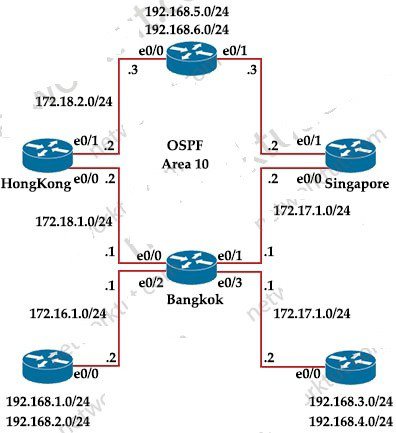
Bangkok is using ECMP to reach to the 192.168.5.0/24 network. The administrator must configure Bangkok in such a way that Telnet traffic from 192.168.3.0/24 and192.168.4.0/24 networks uses the HongKong router as the preferred router. Which set of configurations accomplishes this task?
A.
access-list 101 permit tcp 192.168.3.0 0.0.0.255 192.168.5.0 0.0.0.255
access-list 101 permit tcp 192.168.4.0 0.0.0.255 192.168.5.0 0.0.0.255
!
route-map PBR1 permit 10
match ip address 101
set ip next-hop 172.18.1.2
interface Ethernet0/3
ip policy route-map PBR1
B.
access-list 101 permit tcp 192.168.3.0 0.0.0.255 192.168.5.0 0.0.0.255 eq 23
access-list 101 permit tcp 192.168.4.0 0.0.0.255 192.168.5.0 0.0.0.255 eq 23
!
route-map PBR1 permit 10
match ip address 101
set ip next-hop 172.18.1.2
interface Ethernet0/1
ip policy route-map PBR1
C.
access-list 101 permit tcp 192.168.3.0 0.0.0.255 192.168.5.0 0.0.0.255 eq 23
access-list 101 permit tcp 192.168.4.0 0.0.0.255 192.168.5.0 0.0.0.255 eq 23
!
route-map PBR1 permit 10
match ip address 101
set ip next-hop 172.18.1.2
!
interface Ethernet0/3
ip policy route-map PBR1
D.
access-list 101 permit tcp 192.168.3.0 0.0.0.255 192.168.5.0 0.0.0.255
access-list 101 permit tcp 192.168.4.0 0.0.0.255 192.168.5.0 0.0.0.255
!
route-map PBR1 permit 10
match ip address 101
set ip next-hop 172.18.1.2
!
interface Ethernet0/1
ip policy route-map PBR1
access-list 101 permit tcp 192.168.3.0 0.0.0.255 192.168.5.0 0.0.0.255 eq 23
access-list 101 permit tcp 192.168.4.0 0.0.0.255 192.168.5.0 0.0.0.255 eq 23
!
route-map PBR1 permit 10
match ip address 101
set ip next-hop 172.18.1.2
!
interface Ethernet0/3
ip policy route-map PBR1
Explanation: We need to use Policy Based Routing (PBR) here on Bangkok router to match the traffic from 192.168.3.0/24 & 192.168.4.0/24 and “set ip next-hop” to HongKong router(172.18.1.2 in this case).
Note: Please notice that we have to apply the PBR on incoming interface e0/3 to receive traffic from 192.168.3.0/24 and 192.168.4.0/24.
Refer to the exhibit.
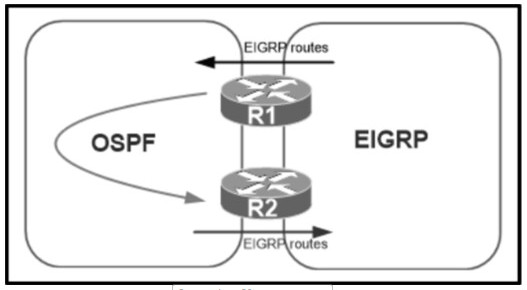
A network administrator configured mutual redistribution on R1 and R2 routers, which caused instability in the network. Which action resolves the issue?
A.
Set a tag in the route map when redistributing EIGRP into OSPF on R1. and match the same tag on R2 to allow when redistributing OSPF into EIGRP.
B.
Apply a prefix list of EIGRP network routes in OSPF domain on R1 to propagate back into the EIGRP routing domain.
C.
Set a tag in the route map when redistributing EIGRP into OSPF on R1, and match the same tag on R2 to deny when redistributing OSPF into EIGRP.
D.
Advertise summary routes of EIGRP to OSPF and deny specific EIGRP routes when redistributing into OSPF.
Set a tag in the route map when redistributing EIGRP into OSPF on R1, and match the same tag on R2 to deny when redistributing OSPF into EIGRP.
Refer to the exhibit.
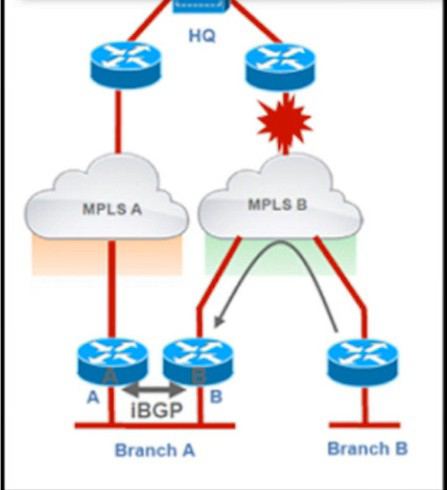
Troubleshoot and ensure that branch B only ever uses the MPLS B network to reach HQ. Which action achieves this requirement?
A.
Introduce an AS path filter on branch A routers so that only local prefixes are advertised into BGP
B.
increase the local preference for all HQ prefixes received at branch B from the MPLS B network to be higher than the local preferences used on the MPLS A network
C.
Introduce AS path prepending on the branch A MPLS B network connection so that any HQ advertisements from branch A toward the MPLS B network are prepended three times
D.
Modify the weight of all HQ prefixes received at branch B from the MPLS B network to be higher than the weights used on the MPLS A network
Introduce an AS path filter on branch A routers so that only local prefixes are advertised into BGP
Drag and drop the LDP features from the left onto the descriptions on the right


Clients on ALS2 receive IPv4 and IPv6 addresses but clients on ALS1 receive only IPv4 addresses and not IPv6 addresses. Which action on DSW1 allows clients on ALS1 to receive IPv6 addresses?
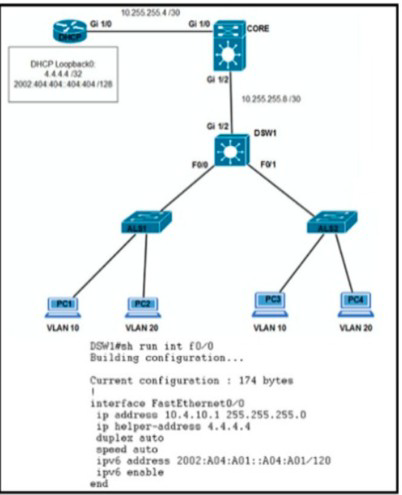
A.
Configure DSW1(config-if)#ipv6 helper address 2002:404:404::404:40
B.
Configure DSW1(dhcp-config)#default-router 2002:A04:A01::A04:A01
C.
Configure DSW1(config)#ipv6 route 2002:404:404:404:404/128 FastEthernet1/0
D.
Configure DSW1(config-if)#ipv6 dhcp relay destination 2002:404:404::404:404 GigabitEthernet1/2
Configure DSW1(dhcp-config)#default-router 2002:A04:A01::A04:A01
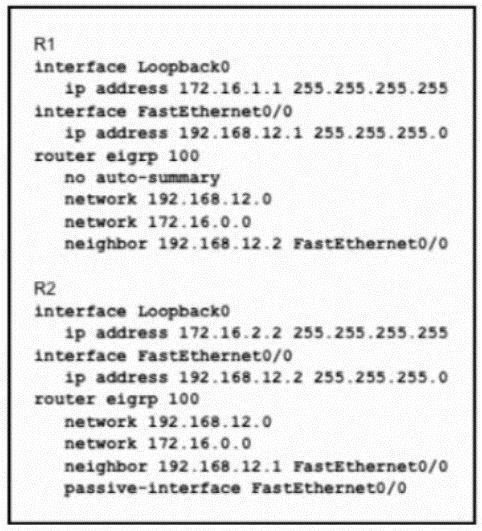
Refer to the exhibit. R1 and R2 cannot establish an EIGRP adjacency. Which action establishes EIGRP adjacency?
A.
Remove the current autonomous system number on one of the routers and change to a different value.
B.
Remove the passive-interface command from the R2 configuration so that it matches the R1 configuration.
C.
Add the no auto-summary command to the R2 configuration so that it matches the R1 configuration.
D.
Add the passive-interface command to the R1 configuration so that it matches the R2 configuration.
Remove the passive-interface command from the R2 configuration so that it matches the R1 configuration.
An engineer configured a Cisco router to send reliable and encrypted notifications for any events to the management server. It was noticed that the notification messages are reliable but not encrypted. Which action resolves the issue?
A.
Configure all devices for SNMPv3 informs with priv.
B.
Configure all devices for SNMPv3 informs with auth.
C.
Configure all devices for SNMPv3 traps with auth.
D.
Configure all devices for SNMPv3 traps with priv.
Configure all devices for SNMPv3 informs with priv.
Explanation: SNMP notifications can be sent as traps or inform requests. Traps are unreliable because the receiver does not send acknowledgments when this device receives traps.”Send reliable and encrypted notifications for any events” so it is SNMP notifications. For encryption we need to configure “priv”.
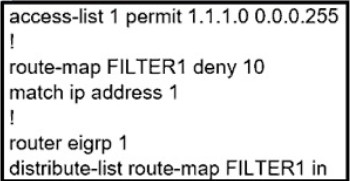
Refer to the exhibit. Which action restores the routes from neighbors while still filtering 1.1.1.0/24?
A.
Add a second line in the access list to permit any.
B.
Modify the route map to permit the access list instead of deny it
C.
Modify the access list to deny instead of permit it.
D.
Add a second sequence in the route map permit 20
Add a second sequence in the route map permit 20
Refer to the exhibit.
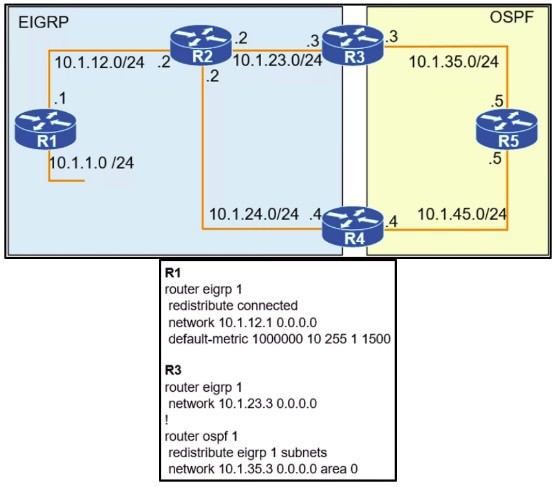
To provide reachability to network 10.1.1.0 /24 from R5, the network administrator redistributes EIGRP into OSPF on R3 but notices that R4 is now taking a ........... path through R5 to reach 10.1.1.0/24 network. Which action fixes the issue while keeping the reachability from R5 to 10.1.1.0/24 network?
A.
Change the administrative distance of the external EIGRP to 90.
B.
Apply the outbound distribution list on R5 toward R4 in OSPF.
C.
Change the administrative distance of OSPF to 200 on R5.
D.
Redistribute OSPF into EIGRP on R4
Change the administrative distance of the external EIGRP to 90.
What are two functions of LDP? (Choose two.)
A.
It is defined in RFC 3038 and 3039.
B.
It requires MPLS Traffic Engineering.
C.
It advertises labels per Forwarding Equivalence Class.
D.
It must use Resource Reservation Protocol.
E.
It uses Forwarding Equivalence Class
It advertises labels per Forwarding Equivalence Class.
It uses Forwarding Equivalence Class
When determining if a system is capable of support, what is the minimum time spacing required for a BFD control packet to receive once a control packet is arrived?
A.
Desired Min TX Interval
B.
Detect Mult
C.
Required Min RX Interval
D.
Required Min Echo RX Interval
Required Min RX Interval
Drag and drop the actions from the left into the correct order on the right to configure a policy to avoid following packet forwarding based on the normal routing path.

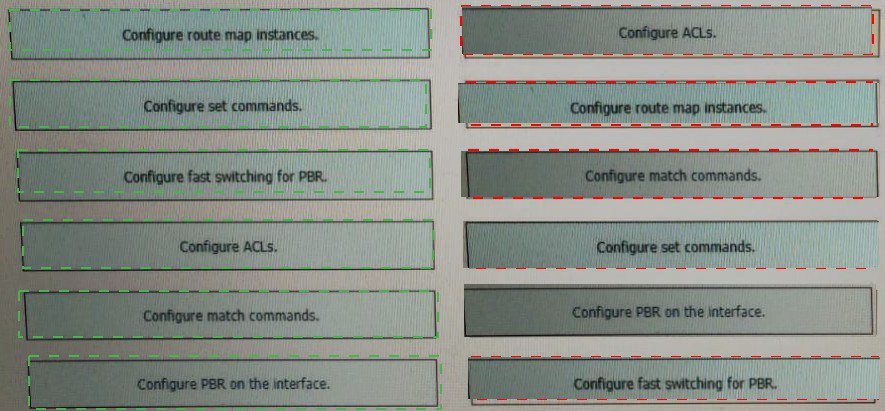
| Page 15 out of 47 Pages |
| Previous |